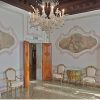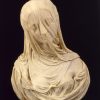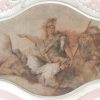The frescoes in this room were commissioned from Antonio Guardi by Maria Barbarigo Savorgnàn and, like the one in the previous room, were painted over during the 19th century and uncovered during a restoration of Palazzo Barbarigo Dabalà in 1936. Stripped from their original location, they were transferred to Ca’Rezzonico in that same year.
On the entrance wall we find Venus and Cupid depicted in front of Vulcan’s forge, while Apollo occupies the wall in front of the fireplace. He is crowned with laurels and a cherub is handing him his quiver. Minerva, on the next wall, is seated among the clouds with a helmet and a spear. Although they are in a precarious state of conservation, these works, the only frescoes by Antonio Guardi known today, still clearly show the painter’s skill in decoration. There is a festive, light effect obtained by the use of soft colours which almost resemble pastels, and by the typical use of open strokes in the outlines, leaving the forms unenclosed.
The splendid marble bust of a Veiled Woman is the work of the Venetian sculptor Antonio Corradini and probably represents the allegory of Purity. He was one of the most renowned sculptors of the eighteenth century and it is no coincidence that, in addition to contributing projects for the decoration of the last Bucintoro, he worked for many European and Italian courts. He ended his life in Naples where he had been called to decorate the famous Cappella Sansevero on commission from the whimsically eclectic Prince alchemist Raimondo di Sangro. The motif of the face covered with a dampened veil is recurrent in this sculptor, who was famous among his contemporaries for his extraordinary virtuoso technique. Instead of concealing the figure, the flimsy veil accentuates the woman’s sensuality and adds a note of intriguing mystery.
The nine armchairs with their curved arms, backs and legs, and the two small chests of drawers with their elegant rounded shape are in green lacquer and decorated with polychrome flowers.


